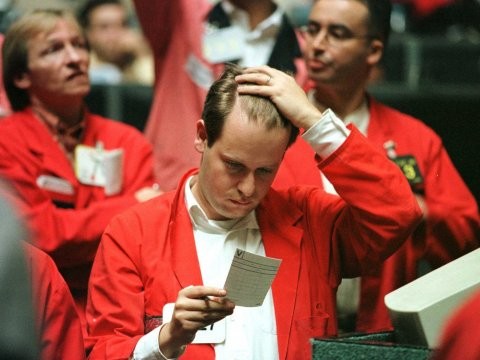Dollar Cost Averaging How Does It Work The Simple Dollar
Post on: 25 Апрель, 2015 No Comment

For quite a while, Ive been interested in how dollar cost averaging works for a regular, steady investment, so I spent some time and used the S&P 500 as a model to see how it worked in the real world.
Wait! Whats dollar cost averaging?
Dollar cost averaging is an investment philosophy in which you buy a particular investment regularly over a period of time with an equal amount of cash each time. When the investments value is high, you dont get as many shares for your dollar; when the value is low, you get more shares for the dollar. In essence, this is what you do when you automatically contribute to your 401(k) out of your paycheck.
Let’s look at a year in which the value of a stock starts at 100, goes up 10 a month until June (the peak), then stays steady for the rest of the year. You paid $134.94 per share with dollar cost averaging. If you instead bought in at the start of the year with your complete investment, then you paid only $100 per share.
On the other hand, let’s look at the reverse market: the stock starts at 100, goes down 10 a month until June, then stays steady the rest of the year. If you invested it all right off the bat, you spent $100 a share for stocks now worth $50, but if you used dollar cost averaging on a monthly basis, you only paid an average of $58.66 per share.
Dollar cost averaging in the real world
To get some real numbers to work with, I downloaded historical data for the S&P 500 since 1950. I used the S&P 500 because that is the index matched by my index fund investment of choice, the Vanguard 500.
I decided to focus on monthly investments in three periods: the last year, January 2006 January 2007; the entire 2000 decade so far, January 2000 January 2007; and the dot-com bust, January 2000 January 2003.
Dollar cost averaging in 2006
In 2006, the S&P 500 went steadily upwards. Using dollar cost averaging and investing $1000 at the start of each month in 2006, you would wind up on January 2, 2007 with an investment worth $13,110.37, a gain of 9.26%.
However, if you had invested the entire $12,000 in on January 3, 2006, your investment would be worth $13,482.66 on January 2, 2007, a gain of 12.36%.
Thus, in a market thats steadily rising, dollar cost averaging causes you to lose some of your gains.
Dollar cost averaging in 2000-2002
From January 2000 to January 2003, the S&P 500 took a major hit, dropping from a month-ending peak of 1454.60 to a month-ending valley of 815.28. Using dollar cost averaging and investing $1,000 at the start of each month in 2000-2002, you would wind up on January 2, 2003 with an investment worth $26,463.88, a loss of 26.48%. Ouch.
But its far, far worse if you invested that $36,000 up front. If you put $36,000 into the S&P 500 on January 3, 2000, it has a value of $22,091.13 on January 2, 2003, a loss of 38.63%.

Thus, in a market thats steadily falling, dollar cost averaging protects you against some losses.
Dollar cost averaging in the 2000s so far
What about over a longer span that incorporates both the down market of 2000-2003 and the subsequent rise since then? Using dollar cost averaging and again investing $1,000 each month, on January 2, 2007 your investment of $84,000 would have a value of $105,086.15, a gain of 25.1%.
On the other hand, if you invested the entire $84,000 on January 3, 2000, it would have a value of $86,637.23 on January 2, 2007, a gain of 3.14%. This is an astounding win for dollar cost averaging.
In a market that falls and then rises, dollar cost averaging is incredibly strong.
What can we conclude?
Dollar cost averaging (what you do by default in your 401(k) investments) is a great strategy to use if youre uncertain about the future of the market. However, if you are unquestionably confident of a bull market, the best strategy is to buy in completely right now rather than averaging it out (which is effectively what you do when you move into a new investment in your portfolio).
In short, for the average investor who is not a prognosticator, your best strategy to minimize your risk is to set up a regular, automatic investment plan and then forget about it. That plan is effectively going to handle the dollar cost averaging for you; just trust that the strategy will protect you against terrible losses in the long run.














